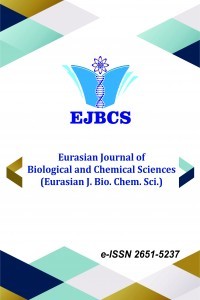Distinctive features of species of Spicara genus in Sevastopol coastal area
Distinctive features of species of Spicara genus in Sevastopol coastal area
Spicara flexuosa, Spicara maena, Black Sea Sevastopol,
___
- Arculeo M, Mauro A, Scelsa G, Brutto S, Cammarata M, Parrinello N. 1996. Protein differences among the Mediterranean species of the genus Spicara. J of Fish Biology, 49(6):1317-1372.
- Bektas Y, Aksu I, Kalayci G, Irmak E, Engin S, Turan D. 2018. Genetic differentiation of three Spicara (Pisces: Centracanthidae) species, S. maena, S. flexuosa and S. smaris: and intraspecific Substructure of S. flexuosa in Turkish coastal waters. Turkish J of Fisheries and Aquatic Sciences. 18:301-311. Boltachev AR, Karpova EP. 2012. Ichthyofauna of the coastal zone of Sevastopol (Black Sea). Mar Ecol J, 11. № 2:10-27. (in Russian).
- Fischer W, Bauchot M-L, Schneide M. 1987. Fiches FAO d’identification des espèces pour les besoins de la pêche. (Révision 1). Méditerranée et mer Noire. Zone de pêche 37. Vertébrés, FAO, Rome. V. II.:1031-1036.
- Gladilina EV, Goldin PE. 2014. New food objects in the nutrition of the Black Sea common bottlenose dolphins Tursiops truncates (Mammalia, Cetacea). Vestnik of Zoology, vol. 48:83-92. (in Russian).
- Hydrometeorology and hydrochemistry of the seas of the USSR. 1991. Reference edition. Project "Seas of the USSR". In: Terziev FS (ed). vol. 4. The Black Sea. №1. Hydrometeorological conditions, Gidrometizdat, Saint-Petersburg, 430 p. (in Russian).
- Imsiridou A, Minos G, Gakopoulou A, Katsares V, Karidas T, Katselis G. 2011. Discrimination of two picarel species Spicara flexuosa and Spicara maena (Pisces: Centracanthidae) based on mitochondrial DNA sequences. J of Fish Biology, 78:373-377. doi:10.1111/j.1095-8649.2010.02858.x, available online at wileyonlinelibrary.com
- Karidas Th, Argiridis N, Minos G. 2009. Sex identification on hermaphrodite picarel Spicara flexuosa (Rafinesque, 1810) based on external characteristics and length frequency analysis. In: Abstracts of the 31st Scientific conference of Hellenic Association for Biological Sciences, Patra, 14-16 May 2009. (In Greek and English).
- Krivokhizhin SV, Birkun AA. 2009. The food spectrum of cetaceans in the Black Sea. Mar Ecol J, vol. 8. №4:67-78. (in Russian). Kuzminova NS, Salekhova LP, Oven LS, Chesnokova II. 2016 a. Biodiversity of ichthyofauna in the coastal waters of Sevastopol. In: Rudneva I. (ed.) Ecotoxicological studies of the coastal Black Sea ichthyofauna in the region of Sevastopol, GEOS, Moskow (in Russian).
- Lakin GF. 1973. Biometrics. Higher School, Moskow (in Russian).
- Lipskaya N.Ya., Salekhova L.P. 1980. The study of nutrition and morphophysiological indicators of fish of the genus Spicara. Ecology of the sea, Iss. 2:66-81. (in Russian).
- Minos G, Imsiridou A, Katselis G. 2013. Use of morphological differences for the identification of two picarel species Spicara flexuosa and Spicara maena (Pisces: Centracanthidae). Mediterranean Marine Science, vol. 14 (3):26-31. doi:http://dx.doi.org/10.12681/mms.423
- Parrinello N, Brutto SLo, Picciurro A, Arculeo M, Rinaldi AM. 1999. Taxonomic study of the family Centrachantidae (Pisces) by RFLP analysis. Biol Mar Medit, 6 (I):719-721.
- Pravdin IF. 1966. Guide to the study of fish. Food. prom., Moskow (in Russian).
- Salekhova LP. 1979. Sparidae fish of the seas of the Mediterranean basin. Naukova Dumka, Kiev (in Russian).
- Schwartz SS, Smirnov VS, Dobrinsky LN. 1968. Method of morphophysiological indicators in the ecology of terrestrial vertebrates. Trudi Instituta Ecologii Rasteniy i Ghivotnih. Iss. 58, 386 p. (in Russian).
- Svetovidov AN. 1964. Fishes of the Black Sea. Nauka, Moskow (in Russian).
- Tortonese E. Fauna d’Italia ‘‘Osteichthyes’’. Pesci Ossei. 1975. Edizioni Calderini Bologna, XI:124-131.
- Tortonese E. 1986. Centracanthidae. In: Whitehead PJP, Bauchot ML, Hureau JC, Nielsen J, Tortonese E (eds.) Fish of the North-eastern Atlantic and Mediterranean. 2. UNESCO, Paris: pp 908-911.
- Turan C. 2011. The systematic status of the Mediterranean Spicara species (Centracanthidae) inferred from mitochondrial 16S rDNA sequence and morphological data. Journal Black Sea/Mediterranean Environment. vol. 17(1):14-31.
- Vasilieva E.D., Salekhova L.P. 1983. Clarification of the diagnoses of a species of the genus based on the study of osteological characteristics. Zoological J, LXII. vol. 7:1044-1056. (in Russian).
- https://www.fishbase.
- Yayın Aralığı: Yılda 2 Sayı
- Başlangıç: 2018
- Yayıncı: Muhammet DOĞAN
Rabia KIRKGEÇİT, Handan ÖZLÜ TORUN
Sevda Esma DARAMA, Semra ÇORUH, Yusuf TİBET
Distinctive features of species of Spicara genus in Sevastopol coastal area
Urtica dioica Bitki Özütlerinin Antioksidan ve Antimikrobiyal Aktivitelerinin İncelenmesi
Sevilay ÇOLAK, Nazan ÇÖMLEKCİOĞLU, Ashabil AYGAN
Phytoplankton composition of Hirfanlı Dam Lake (Kırşehir-Turkey)
Atiye Püren CEYHAN, Hakan AKTAŞ
